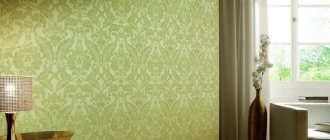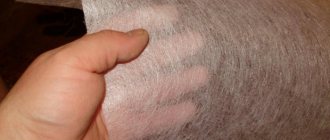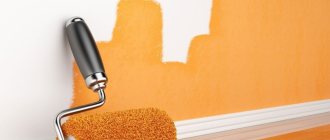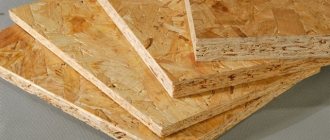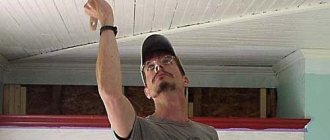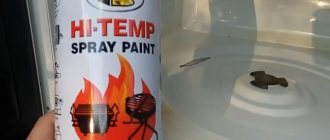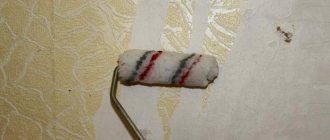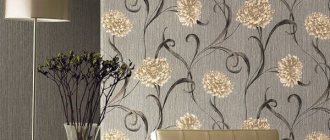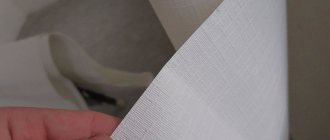11425 0 0
Andrey July 23, 2017 Specialization: facade finishing, interior finishing, construction of dachas, garages. Experience of an amateur gardener and gardener. We also have experience in repairing cars and motorcycles. Hobbies: playing the guitar and many other things that I don’t have time for :)
Is it possible to paint vinyl wallpaper, and how to achieve a high-quality result? Previously, I was often interested in this question, but now, having experience and knowledge, I will answer it myself. I am sure that this information will help beginners quickly update their home interior.
Painting allows you to give vinyl wallpaper any shade
About painting vinyl wallpaper
Can you paint or not?
I’ll say right away that there are special paintable vinyl wallpapers on sale, i.e.
The question of painting this material, in principle, disappears by itself. But is it possible to paint wallpaper without painting? It all depends on what type of vinyl wallpaper is glued to the wall. Paintable vinyl wallpaper has a white surface
As you know, this finishing material comes in two types:
- Paper based . It is not advisable to paint such canvases, as there is a risk of moisture penetrating under the top vinyl layer, which will lead to them sticking off the wall. True, some paper-based wallpapers successfully withstand this operation, but, in any case, you will have to make a decision at your own peril and risk;
Vinyl wallpaper contains a multi-layer structure
- On a non-woven basis . These fabrics are more resistant to moisture, so there is no risk of them peeling off. However, during the painting process some problems may arise - uneven coloring as a result of the porous structure of the vinyl foam, as well as the appearance of the color of the wallpaper. I will tell you how to solve them below.
From this we can conclude that it is better to immediately purchase trellises for painting if you plan to repaint the walls over time.
For frequent repainting of walls, it is better to purchase glass wallpaper for painting. High-quality models of these canvases can withstand up to 20 repaintings. Moreover, their service life can reach 50 years.
Which paint to choose
To paint vinyl wallpaper, use water-based paint. The fact is that this paint and varnish material has good adhesion. In addition, it has several other important advantages:
- No smell. This is due to the fact that the composition does not contain organic solvents - water is used instead;
- Environmental friendliness . After painting the walls, it is absolutely not necessary to leave your home, as is the case with using oil paint;
- Drying speed . This indicator depends on the time during which the water evaporates from the surface of the walls, i.e. on average, the paint dries within a few hours;
Acrylic paint can be tinted
- Possibility of tinting . Thanks to this, you can give the walls any color or shade. The only thing is that you need to choose the right color (combination of colors) and its proportions;
- Durability . High-quality water-dispersed paints do not crack or lose color, as a result of which they can last more than 10 years.
It must be said that there are several types of water-dispersion paints on sale:
This usually confuses newbies and makes it difficult to choose. In reality, it does not matter at all what type of polymer the paint contains. The main thing is to pay attention to the following characteristics when choosing:
- Gloss level . The coating can be matte, semi-gloss, or less often glossy;
Painted vinyl wallpaper most often has a matte surface
- Level of moisture resistance and abrasion . Conventionally, paints can be divided according to this indicator into three types - non-moisture-resistant, moisture-resistant and water-resistant. If the former cannot withstand the effects of the vaga at all, then the latter can be subjected to careful wet cleaning. Waterproof ones can withstand direct contact with water and even detergents.
The choice of moisture resistance depends on the room in which you want to paint the wallpaper. For example, you can even use non-moisture resistant paint in the bedroom. For a kitchen or children's room, it is more advisable to use a waterproof coating.
In the photo - high-quality waterproof paint from the Finnish manufacturer TIKKURILA Lumi
Another important point is the quality of the paint, which depends solely on the manufacturer. Below are paints and varnishes from some manufacturers that have proven themselves well:
| Brand | Price in rubles |
| VGT moisture resistant 1.5 kg | 200 |
| TIKKURILA lumi (waterproof) 9l | 11690 |
| Chief technologist 1.5l | 175 |
| PUFAS INTERIOR moisture-resistant, 10 l | 830 |
| DALI 9l | 1153 |
Prices are current in summer 2021.
What else can be done - 3 interesting techniques
Many owners are often interested in the question: “Is it possible to paint ordinary wallpaper using non-standard techniques?” Indeed, there are various painting methods used by professional installers, but this does not mean that they cannot be used at home.
Partial painting involves painting the surface with a roller, after which, without waiting for the vinyl to soak, the paint is wiped off with a damp sponge
Alternative dyeing methods are possible due to the positive qualities of non-woven vinyl materials. The top layer of such cladding is dense vinyl, almost without pores, which slows down the process of paint impregnation, but does not stop it. Long-term absorption ensures the highest quality fixation of pigments in vinyl, that is, the dye after repair can no longer be erased or washed off. Non-woven fabric, on the contrary, absorbs moisture well, due to which it quickly becomes colored, but retains pigments less well.
These features of the material made it possible to use several interesting paint application techniques:
- Partial coloring. This technique involves painting the surface with a roller, after which, without waiting for the vinyl to soak, the paint is wiped off with a damp sponge. As a result, the vinyl layer is painted, but the non-woven base is not. This gives the walls a deep, voluminous appearance, as the initial color of the coating shows through a little through the applied layer of paint.
- Coloring the non-woven layer. This technique involves painting the inner layer of the material before gluing it to the walls. The roll is cut into pieces of the required size, after which paint is applied to their reverse side with a roller. Gluing is carried out after the paint has completely dried. The effect of this staining method is similar to that described above.
- Use multiple colors. The method involves preliminary selection of the main and additional colors of the dye. After pasting the walls, the surface is painted with a roller in one layer, and then the structural details are drawn in contrasting shades with a brush. This technique allows you to use almost any number of colors for interior decoration, but requires professional skills.
Alternative painting techniques can be overwhelming, but anyone can paint vinyl siding without them. To do this, you don’t need any expensive tools or special knowledge, the main thing is to choose the right materials and believe in yourself!
Painting technology
Painting vinyl wallpaper includes several basic steps:
Stages of painting vinyl wallpaper
The instructions for doing the work look like this:
| Illustrations | Description of actions |
| Tools and materials: |
- Paint roller . If the wallpaper has deep relief, you should use a roller with medium or even long pile for painting;
- Roller container . You can purchase a special tray or use any flat container;
- Paint brush . It must be of high quality so that the lint does not come out of it;
- Primer . If you have vinyl wallpaper to be painted, you can use a transparent universal acrylic primer. If the wallpaper is ordinary and has color, it is better to treat it with pigmented primer. It will not only improve the adhesion of the paint to the base, but will also paint the canvas white.
- Kohler . It will be needed to give the paint a certain color if it is initially white.
- Wallpaper must be cleaned of any possible contamination. To do this, they need to be wiped with a damp sponge; you can even use soapy water;
- Then the surface should be allowed to dry, after which it can be treated with a primer. If you paint foam vinyl, it is advisable to coat the surface with primer several times to close all the pores.
Professional answer: Is it possible to paint vinyl wallpaper (video)
So, you need to paint it. The best result after painting will be when using special wallpaper for painting. The most suitable are vinyl and non-woven fabrics, also foam type with a pattern. To paint wallpaper, you need a paint container, brushes, paint, and paint rollers. Water-based paint is most suitable. According to their characteristics, paints come in matte, semi-matte and glossy, semi-gloss and satin finishes. The most versatile of these types are satin paints, suitable for use in all rooms. Before painting, vinyl wallpaper is pre-prepared and then painted like regular surfaces.
Related article: Decorative design of asphalt. Making an ordinary coating unusual
Conclusion
Now you know whether vinyl wallpaper can be painted and how to do it correctly. But before you get started, I recommend watching the video in this article. And if you haven’t found the answer to a question on the topic raised, ask it in the comments, and I will be happy to answer you.
Apartment renovation always involves a complex choice of materials for finishing the room. One of the most popular ways to diversify the appearance of walls is to wallpaper them. There are various types of wallpaper, and vinyl is considered one of the most popular among them. The building materials market offers various options for their colors and structures, but if you still can’t find the right ones, the best solution is to paint the wallpaper.
Paint for vinyl wallpaper - which enamel is suitable?
When thinking about how to paint vinyl wallpaper, remember that to ensure attractive characteristics it is not enough to choose the right wallpaper; you also need to choose the paint wisely, because not all modern dyes are suitable for such work. Firstly, you should not use paint based on strong chemicals and solvents. They can destroy the structure of the facing coating. Secondly, toxic dyes should not be used inside residential premises.
Water-based paints are best suited for painting wallpaper. We recommend choosing among them, taking into account the desired effect:
- Water-based paint. Suitable for covering surfaces in bedrooms and children's rooms. It has a soft, glossy color, creates an attractive finish that does not accumulate dust and does not leave handprints. However, water-based paint is afraid of water, so it is not suitable for bathrooms and kitchens and does not allow you to wash the wallpaper after the final finishing.
- Acrylic paint. Has a lot of positive qualities. Firstly, it dries very quickly, secondly, it can be used to paint surfaces using complex techniques and several colors, thirdly, it is resistant to moisture and can be washed using a soap solution.
- Latex paint. The most expensive and high-quality material, which can be an excellent answer to the question of how to paint old wallpaper. The paint provides a glossy finish to surfaces, repels water and has a long service life. Ideal for painting wallpaper in bathrooms, toilets, hallways and kitchens.
Vinyl wallpapers and their varieties
Vinyl wallpaper is a material made of two layers - bottom and top. Depending on what they are made of, vinyl coverings are classified:
- bottom layer or base. It's thicker. There are non-woven and paper-based wallpapers;
- top layer or decorative.
There are several types of vinyl wallpaper appearance. They are suitable for various premises. For example, for the kitchen and bathroom, denser and moisture-resistant varieties are made, consisting of several layers of polyvinyl chloride, and some options are made using hot stamping technology, applying different textures. There are:
- foamed vinyl;
- flat vinyl;
- silk-screen printing;
- polyplen;
- hard vinyl.
It is possible to paint only wallpaper made of foam vinyl and non-woven backing, since they absorb paint and do not deform under the influence of the water contained in it. Currently, manufacturers indicate whether painting is possible, and also produce separate lines “for painting” in white or other light shades with a variety of reliefs. When choosing a wall covering, you should take into account its relief: the more complex and small the pattern depicted on the wallpaper, the more difficult it is to paint it. A voluminous ornament will require more paint and layers.
If this is your first time painting the walls yourself, it is better to give preference to wallpaper with a small and simple pattern.
Coloring methods
Painting a wall can be done in different ways. Each individual case depends on what tools are used, what technology is used, what pattern will be created. There are four main methods for painting vinyl wallpaper.
Painting technologies
Before gluing
You can prepare the canvases for gluing in advance. To do this, the sheet is measured along the wall, laid on a flat surface and painted. The prepared material can be glued no earlier than 60 minutes later. The result is a neat workpiece that forms a light, beautiful coating.
After pasting
After the canvas has already been glued to the wall and has completely dried, or the wallpaper has been there for a long time, you can proceed directly to painting. To apply an interesting pattern, you can use flat stencils or their analogues on a roller.
With rubbing
This method differs from others by the presence of an additional stage of wall processing. After the paint has dried, the painted part is rubbed with dry material, most often with a clean rag. Additionally, a lighter tone is obtained, and also somewhat speeds up the drying process.
Selective drawing
This technique involves first applying the main color, and only then painting the relief. This helps to create contrasting patterns or, conversely, create harmonious, subtle shades.
What to paint with?
Along with a huge selection of wallpaper, there are many types of paint, and having decided on the first, you need to pay no less attention to the second. Basic rule: paint should not contain chemically active or toxic substances. Organic-based paints are not suitable for painting: oil-based, alkyd, enamel. Glue and silicate options are also not the best option not only for vinyl wallpaper, but also for wall coverings in the house in general.
Water-based paints are perfect ; they are easy to apply, and you can buy ready-made ones of a certain color or give the desired shade yourself using special dyes. With its help, the surface can be made matte, glossy (semi-gloss) and satin. A matte finish looks great in large rooms, while a glossy finish will help visually expand small and dark rooms. The satin surface is suitable for any room size. Water-based paints are:
- water-imulsion. This coating is antistatic and has many other advantages, but is not intended for wet cleaning: if you wipe the wall with a wet cloth, the paint will remain on it;
- dispersive. Water-based paint made from synthetic polymers (scrap or petroleum). After applying the mixture to the wall, the water evaporates and the solid particles form a smooth and impermeable surface;
- acrylic. This paint dries quickly, does not mix when applying several shades, and can withstand washing, including the use of cleaning agents;
- latex. They are expensive, but they allow you to create an even, glossy finish with a long service life. The paint can be used on walls covered with old wallpaper.
Water-based paint should be used to paint walls in the bedroom, nursery or living room, acrylic and latex paint in any room, dispersion paint is ideal for the kitchen or bathroom. Before purchasing paint, calculate its required volume depending on the type of wallpaper, area of the room and the desired shade. If the paint is not tinted immediately, then it is worth purchasing a color scheme. Its quantity depends on the brightness of the color that is needed. After mixing the paint and dye, apply the mixture to a small area of wallpaper or wall and wait until it dries completely to determine the final color.
Usually the paint is sold quite thick, and it is difficult to apply it to the walls. It is enough to dilute it with ordinary clean water to a consistency reminiscent of sour cream. You can also repaint old walls with any type of paint. In order for it to lay flat and not peel off, you must first treat the existing coating, remove dust and dirt, and fill in imperfections.
In some cases, additional priming may be required.
Tools and paint
Before painting, you need to stock up on tools and paint.
First of all, you need to decide on the color scheme and buy the required amount of paint - as much as is required to completely paint the walls of the room. The photo shows a variety of colors that you can mix and choose the desired color scheme.
Attention! It is better to take paint for vinyl wallpaper with a small reserve, since sometimes something will need to be corrected or painted during the process, for example, a corner.
For vinyl wallpaper, the best option is water-based acrylic or dispersion paint. They are:
- matte - best suited for large rooms;
- semi-matte or semi-gloss - used in bedrooms or children's rooms, looks good in the kitchen;
- glossy coatings are used in dark rooms, as they reflect light well;
- The satin effect option is suitable for all rooms.
Water-based paints adhere well, painting the entire surface in an even layer.
Tools for painting you will need:
- paint roller;
- paint tray;
- brushes for painting hard-to-reach places;
- a roller with a stencil, if you decide to apply some kind of pattern on top.
The required set of tools is clearly visible in the photo.
How to paint?
Wallpaper and paint have been selected, and next comes painting. Before you begin, you should choose a paint application method:
- before wallpapering. In this case, the paint is applied to the wallpaper strips before gluing them to the wall. It is necessary to cut the panel of the required length from the roll, apply paint and after drying (after about an hour) begin gluing;
- If the wallpaper has already been glued, then you should wait until the glue has completely dried (the drying time is usually indicated in the instructions for it), and only then paint it.
Various dyeing techniques
Before starting work, you need to choose a painting method:
- Before gluing the wallpaper, the dye is applied to it before gluing it to the walls. You need to prepare the panel, cut it from the roll, paint it and after an hour, when the paint has dried, stick it on the surface.
- If the wallpaper is already pasted, then you need to wait until the glue is completely dry and then start painting. The drying time of the glue is indicated in the instructions for use. The paint is applied with a brush, spray gun, or spray gun.
If you paint with a roller, then you need to choose the right length of the pile: to treat a textured surface, the pile should be longer. A foam tool will damage the texture and make it impossible to apply the paint evenly.
Please note: Painting a timber house outside and inside
To work you will also need:
- masking tape;
- tray;
- rag.
The floor must be covered with cellophane or paper. The worker must wear safety glasses, gloves and a hat. If you need to paint the ceiling, you need to use a roller extension.
Procedure for painting vinyl wallpaper:
- First, you need to seal with masking tape all the joints of the surface that will be painted with the doors, baseboard and floor.
- Cover furniture and other surfaces with cellophane.
- Use a vacuum cleaner or damp cloth to clean the surface to be painted.
- Then you need to mix the paint and pour a little into the paint tray.
- The ceiling should be painted first, then the walls.
- The walls are painted from bottom to top.
If the paint will be applied in several layers, then before applying a new layer you need to wait until the previous one has dried. After 2-3 days the tone will appear completely. To achieve a more uniform color, it is recommended to spray paint the surface. If it is not available, use a roller, and to paint the corners, use a small brush.
Painting vinyl wallpaper using the rubbing method.
Rub dyeing method
This method will make the pattern more convex. After applying the paint, wipe the coating with a soft cloth, thus removing the top layer of paint. The work must be done with an assistant: one person paints the surface, the second wipes it with a cloth.
Selective Pattern Creation Method
Apply the required number of layers of paint, then use a brush to pick up paint of a darker color and highlight the pattern with it. This work requires a lot of time and is suitable for surfaces with original relief.
Method of decorating wallpaper before gluing it to the surface
This method is used if different types of wallpaper are pasted. A dye is applied to them on the inside, after which it dries they are glued to the wall. If several shades are used, masking tape is used to separate them. This method is suitable for working with wallpaper that has a fine texture, because... Where the tape touches the base, the paint will bleed and the lines will be uneven.
Stores sell rollers with patterns printed on them. Using this tool you can apply a pattern. In this case, you need to ensure that the wallpaper is evenly glued so that the pattern is not disturbed.
Sponge method
When applying the last layer, the sponge is dipped into the paint and touched to the surface; a textured imprint is obtained on the wallpaper. The method is time consuming.
Pay attention to: The second life of shoes: the nuances of painting yourself
Painting wallpaper: advantages and disadvantages
Painting vinyl wallpaper is a simple and inexpensive way to give your interior the desired look. The diversity of the presented range of vinyl wallpapers will allow you to realize any idea. If you choose a simple relief, you can update the appearance of the room almost every year simply by changing the paint color. This can be done quickly, with your own hands, and there is no need to purchase complex tools.
The disadvantage of painting wallpaper is paint splatters that fly off from a roller or sprayer, but dealing with them is easier than removing old wallpaper and gluing new ones. Vinyl wallpaper can be painted, it can be done quite conveniently and inexpensively , the main thing is to approach the process in an organized manner, choosing the right type of wall covering and paint.
You will learn more about how to paint wallpaper in the following video.
A popular type of wall decoration - painting wallpaper with water-based paint - has several undeniable advantages. But the work must be done in accordance with the rules, otherwise the effect of the repair may be unexpected.
What paper-based vinyl wallpaper can be painted?
There are two types of paper-based vinyl wallpaper: standard and “paintable”. The information on the wallpaper's accompanying label must indicate that the wallpaper can be painted. If there is such a mark, you can safely choose them. Typically, such wallpapers have a non-smooth surface and light, soft colors: beige, light blue, light green and others. The uneven surface of the vinyl layer will retain paint well, and unsaturated colors can easily be painted over with a different color. If you buy vinyl wallpaper in a rich color, it will be much more difficult to repaint it. In principle, standard paper-based vinyl wallpaper, which does not have direct recommendations, can also be painted, but difficulties cannot be avoided along the way.
What wallpaper can be painted with water-based emulsion?
The choice of water-based paint for wallpaper is dictated primarily by its price. Mixtures based on latex or polyvinyl acetate are also suitable for paintable wallpaper, but are a little more expensive. Water-based dye has long been known to Russian residents, is familiar and relatively cheap. Among its other advantages:
- possibility of tinting the white base in any shade;
- resistance of the painted surface to fading and abrasion;
- easy to clean (can be wiped with a damp cloth to remove dirt);
- environmental friendliness;
- no pungent odor upon application.
Is it possible to paint vinyl wallpaper - select paint
First you need to select the finishing material and prepare all the necessary tools. Embossed vinyl wallpaper in white or pastel colors is best suited. You will also need glue that prevents the proliferation of microorganisms, paint, a roller, a brush and plastic film that will cover the floor.
Cut strips of finishing material are glued to the wall surface in accordance with the instructions, after which the wallpaper must be given time to dry - usually at least a day. Before direct painting, the surface is cleaned of dust and degreased.
If you are wondering how to paint vinyl wallpaper, do not worry - it is not difficult to find a suitable composition. A good “water emulsion” may also be suitable for painting. The beauty of this paint is the ability to create a matte surface on which handprints are practically invisible, which is especially important if there are children in the house.
Latex or acrylic based vinyl wallpaper paint allows you to achieve a stunning glossy effect. In addition, it dries quite quickly - within 5 hours. But you can admire the end result after three days, when the coating acquires shine and color saturation. To maintain the gloss in its original form, you will have to wipe the surface every now and then, because even the slightest stains will be very noticeable on shiny wallpaper.
You can paint vinyl wallpaper in four ways. The traditional method is to paint the coating on the front side after gluing. This is the simplest method and should not cause any difficulties. If new wallpaper is painted, it is usually painted twice. The interval between applying the first and second layers is one hour. The second option is to paint the material from the inside before gluing it to the wall. The “trick” is that non-woven wallpaper has different characteristics on the back and front sides - the back side absorbs moisture and color better, so that the desired shade appears on the front side. In this case, the canvas should be glued only after the paint has completely dried. The paint is applied using a roller or brush.
A relatively labor-intensive but effective painting method is based on the different properties of the non-woven base and PVC. If the non-woven fabric quickly absorbs paint, then it will dry for a long time on a layer of foamed PVC, so you can easily wipe it off with a sponge or piece of cloth. Thanks to this, you can highlight individual details or entire patterns and make them lighter. The work is very difficult, you can’t do it without helpers, but it’s worth it.
The next method is an even more complicated variation of the previous one. In addition to the fact that the details of the patterns are cleared of paint, they are also painted in a different color. The main thing in this matter is to choose colors that are in harmony with each other, so that bright patterns look good against the background shade.
How to prepare for work?
Before painting the wallpaper with water-based paint, you need to prepare all the necessary materials. To work you will need the following:
- paint roller (long pile);
- velor roller (for embossed wallpaper);
- flat brush 6-7 cm wide;
- roller cuvette;
- masking tape;
- water-based paint (white base);
- color.
You can tint purchased white paint directly in the store. Large companies offer a computer shade selection service. The specialist will calculate the amount of dye needed to obtain a suitable color. The information will be saved in the program’s memory: using the shade number, you can order an additional volume of the same color if repairs are required or there is not enough material.
If the wallpaper has already been pasted and is being repainted, then before starting work you should wipe the surface with a damp cloth. This will help remove dust and other contaminants that could leave streaks on the new coat of paint or prevent the paint from laying flat (grease stains). The cleaned surface must be dried for 1-2 hours, and then proceed to painting the walls.
How to paint vinyl wallpaper - painting features
It is believed that vinyl wallpaper can withstand up to 10 paintings, but in fact they only have a pleasant appearance after the first five. The subsequent change of color simply affects the clarity of the pattern on the wallpaper. Whether the wall covering will be washable depends on the composition of the paint, so when purchasing, pay attention not only to the beautiful shade, but also to the ability to wash the walls after painting.
By the way, wallpaper produced specifically for painting is much cheaper. Of course, the cost of painting materials, brushes and rollers will be no less than the amount of savings, but you will still receive an undoubted benefit - the opportunity to experiment!
Please note that if you intend to turn to master builders for services, they will most likely charge double rates for their work - for wallpapering and for further painting.
High-quality wallpaper that can be painted is produced by many foreign manufacturers. Germany, France, Finland, Belgium, Sweden - the best materials are produced in these countries. Calculating the required number of rolls is no different from calculating regular wallpaper. Please note that wall coverings with structural patterns can be produced in somewhat unusual formats - in longer rolls and wider strips.
This format almost completely eliminates the appearance of scraps and also significantly reduces the number of joints. True, gluing wide sheets without outside help will not be easy. If two people are enough to hang regular wallpaper, then in the case of wide material for painting you will need another pair of hands.
Source: remoskop.ru
How to paint different types of wallpaper?
New wallpaper must be thoroughly dried before painting. It usually takes 24-48 hours after sticking them on the walls. If the repair was carried out more than 2-3 days ago, then painting can be started at any time.
The biggest concern is the paper covering. But if you work carefully with a roller, even this fragile material will not be damaged. When painting paper wallpaper, you can also use a non-contact method: using a paint sprayer.
The first stage is painting the corners of the room, where the walls meet the ceiling or baseboard. If it is possible to remove the baseboards, sockets, and decorative door trims, then it is better to do this before painting the walls. But in old buildings you will have to cover the edges of these interior parts with masking tape. This measure will protect the surfaces of parts from water-based paint, which is more difficult to wash off after drying.
You need to paint difficult areas with a soft paint brush, without trying to press it too hard. Walls near doorways, corners, rosettes and other protrusions should be painted by hand to a width of about 5 cm. Without waiting for the paint to dry, proceed to the next step:
- Pour a little coloring composition into the cuvette and roll it with a roller along the ribbed surface to thoroughly saturate the pile.
- Start painting from the middle of a small area in the upper corner of the wall. Move from the center to the edges, capturing part of the pre-painted stripes.
- When the paint on the roller has dried up, roll it several times over the water-based emulsion poured into the ditch. Continue working in the specified sequence.
You need to paint 1 wall in 1 step, not allowing the paint to dry on the edges of adjacent areas. When applying the emulsion to a new area, use a roller to cover 1-2 cm of the already painted surface. This way the paint will lay down in an even, continuous layer.
Next, dry the surface and apply another layer of dye. When working, observe the same conditions as when treating the surface for the first time.
Vinyl wallpaper for painting - material features
Ordinary paper wallpaper, even two-layer, may not withstand even one painting. But non-woven or vinyl products will not only withstand, but also, figuratively speaking, say thank you. This wallpaper has a two-layer structure. The bottom layer is the base, which can be made of thick paper or non-woven fabric. The top layer is a protective coating made of polyvinyl chloride, or simply put, PVC. Vinyl wallpaper can be divided into three types: kitchen, foam (volumetric) and flat.
Kitchen wallpaper is produced with a good thickness and smooth texture, so it is easy to clean it from dirt. Foamed ones are indispensable on uneven surfaces, as they perfectly hide all the imperfections of the walls. True, the soft structure of the material is quite susceptible to mechanical damage. Painting such a surface will not only change the appearance of the wallpaper, but will also create additional protection for the foamed PVC.
Well, flat wallpaper (satin, silk-screen printing) is made with a much smaller thickness than previous types of finishing material, but is distinguished by an exquisite design, which is good in itself. Painting flat vinyl wallpaper simply does not make sense, since a layer of paint will hide the subtle interweaving patterns, although it is quite possible.
It may seem that we are talking about completely different wall coverings, but they all have the same quality characteristics:
- Good density and elasticity of the material. Therefore, they are very difficult to tear when gluing and during use.
- Moisture resistance – the coating can be wiped with a damp sponge and even treated with special detergents.
- Non-exposure to ultraviolet rays - able to retain their original appearance for a long time.
- They tolerate mechanical damage very well.
- Large selection of textures and amazing design. The material can imitate the surface of wood, suede, ceramics and even plaster.
Along with numerous advantages, paintable vinyl wallpapers have one significant drawback - they do not allow air to pass through. It is due to the airtightness of this finishing material that mold can form under the coating. Therefore, experts recommend either using antibacterial glue, or generally refraining from gluing such a covering in the bedroom and children's room.
How to paint interlining and vinyl?
Non-woven wallpaper (with or without vinyl coating) can be painted before hanging on the wall. Coloring is done from the inside out. In this case, the paint will saturate the loose material, protruding on the front side.
This method of painting is good because the wallpaper can be wiped with a damp sponge without the risk of washing off the paint. A transparent vinyl layer on the surface will also protect the non-woven base. Wallpaper coated with vinyl is moisture resistant and can be used in the kitchen or bathroom.
The foam vinyl coating will not allow you to paint the wallpaper before gluing it. Embossed trellises can be painted in the usual way, using a long-pile roller. In this case, the paint will get into the depressions of the embossed design.
Dyeing process
Before applying paint to the surface, you must make sure that the wall is completely dry. As already mentioned, vinyl wallpaper on a paper base takes much less time to dry than on non-woven wallpaper.
First, paint those places where using a roller is problematic. These are primarily angles. They are painted with a brush, trying not to miss the most inaccessible places: surfaces behind stationary heaters, such as radiators and radiators, as well as places near ceiling and floor skirting boards.
Then pour the required amount of paint into the tray, wet the roller and roll it on the ribbed surface, removing the excess.
Painting walls with a paint roller is not difficult for a novice master. If your experience is not too great, then you can start painting from the places where you plan to place furniture in the future. This is how you gain the necessary experience and skill.
For painting, you can use a spray bottle. But in this case, the floor must be covered with dense material, and a mask must be put on the face.
The painting may not be of the highest quality, and some flaws may be visible, so vinyl wallpaper is often painted twice.
Typically, this painting method is used on already glued canvases.
There is an original way of painting newly pasted vinyl wallpaper on a non-woven backing.
To obtain the desired color, a piece of wallpaper is painted from the inside out. In this case, water-based paint is applied with a roller or brush. The result is shown in the photo below:
The reverse surface of the non-woven base absorbs moisture better and it is much easier to obtain the desired shade. But it is worth noting that gluing is done only after the paint has dried on the canvas.
The process is labor-intensive and complex; it is difficult for an amateur to do repairs without the help of a more experienced craftsman.
Fiberglass wallpaper
They are best suited for dyeing. To highlight the relief, painting can be done in several layers:
- apply 2 layers of base paint of the desired shade;
- After drying the base, use a velor roller to highlight the protruding parts of the pattern with a different color.
Shades for this coloring are chosen according to taste. You can keep the pattern in a single color scheme, but contrasting shades look no less impressive.
Fiberglass wallpaper can be repainted up to 10 times. This makes repairs easy and economical. If you want to refresh the interior, you can quickly cope with the task by repainting part of the surface or highlighting one wall.
You can even paint ordinary non-woven and thick paper wallpapers that are not intended for this. But the paint will stick worse on vinyl film, so when choosing, you should pay attention to the labeling of the wallpaper.
| Surface preparation: |
| Paint preparation: |
| Painting: |
Some features of vinyl
Typically, experts say that non-woven vinyl wallpaper can withstand up to ten stains. But in practice, the relief pattern is visible only up to the fifth time, so during subsequent painting you should pay attention only to the shade of the color. The texture of the drawing will be viewed much worse.
It is worth paying attention to the following factor: whether the wallpaper will be washed during use after painting. Based on this, the paint is selected.
In the photo - vinyl wallpaper on a non-woven basis in the kitchen:
When purchasing, you need to calculate the exact amount of paint for repair. It should be taken into account that non-woven vinyl wallpaper is often produced in longer rolls than regular standard ones. The width of the pieces also differs from simple paper ones.
But when buying vinyl wallpaper of this size, you need to take into account that there will be significantly less scraps, the number of joints will be reduced, which will undoubtedly give the room a more aesthetic appearance.
How to choose paint
This material is easy to paint, and there are several painting options.
To get started you need to do:
- Select color option.
- Select the variety, shade and type of paintwork.
- Make purchases for the necessary materials and tools.
And now you can begin work on vinyl pasting.
Is it possible to paint
Many home craftsmen are wondering whether vinyl wallpaper can be painted. In order for the work to bring a positive result, it is necessary to make sure that a certain type of canvas can be painted. There are three types of similar wallpapers on the market today.
The first ones are kitchen ones and contain two-layer vinyl. They are moisture resistant and durable, they are easy to clean, quite often they have a relief appearance and imitate tiles or tiles. Use this wallpaper to cover walls in the bathroom or kitchen. You can paint them, but this is not done so often.
